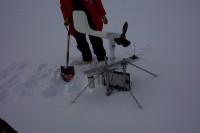By Mike Dubrasich, Western Institute for the Study of the Environment (WISE)
The latest issue of Nature boasts the cover story: Antarctic Warming. The problem is that the research paper being touted is based on bad data.
Statistician, global warming skeptic, and blogger Steve McIntyre of Climate Audit [here] has discovered that the Antarctic weather station data—upon which the paper in Nature was based—was tainted. Temperature data from two different stations, “Harry” and “Gill” in West Antarctica were combined to produce an erroneous uptick in historical readings.
In addition, meteorologist, weather station guru, and blogger Anthony Watts of Watts Up With That has demonstrated that numerous Antarctic weather stations may have serious data problems. Snow has piled up around temperature sensors—effectively insulating the temperature monitoring stations from the bitterly cold extremes of the southern-most continent [here ].

A University of Washington Press Release dated January 21, 2009, hailed new findings of a team led by UW professor Eric Steig. It noted “Scientists studying climate change have long believed that while most of the rest of the globe has been getting steadily warmer, a large part of Antarctica—the East Antarctic Ice Sheet—has actually been getting colder.
But new research shows that for the last 50 years, much of Antarctica has been warming at a rate comparable to the rest of the world. In fact, the warming in West Antarctica is greater than the cooling in East Antarctica, meaning that, on average, the continent has gotten warmer, said Eric Steig, a University of Washington professor of Earth and space sciences and director of the Quaternary Research Center at the UW. The study found that warming in West Antarctica exceeded one-tenth of a degree Celsius per decade for the last 50 years, and more than offset the cooling in East Antarctica.” The story was picked up by newspapers around the world.
Now it turns out the data used was faulty and erroneous. Various climate skeptics pointed out immediately that a temperature rise of one-tenth of a degree Celsius per decade was too small to be detected, especially when temperature stations in Western Antarctica are few in number across such a vast, continental area. The “interpolation” statistics used by the authors were also called into question (NASA noted in 2007 that the “The scientists estimate the level of uncertainty in the measurements is between 2-3 degrees Celsius”.).
But until last Sunday, no one had examined the actual data. That is when Mr. McIntyre and contributors to his blog, Climate Audit, discovered that the readings of stations “Harry” and “Gill” had been combined in such a way as to show a false upward trend. Gill temperature readings from 1987 to July 1994 were spliced with Harry readings from December 1994 to 2000. Since Gill is at a relatively snow-free location, its temperatures were slightly colder than at snowier Harry. When the two stations were treated as one, an erroneous upward trend resulted. McIntyre also discovered data flaws at the Chatham Island weather station last June. When the data flaws were reported Monday, the British Antarctic Survey (BAS) initially erased Harry and Gill from its database. Emails from Mr. McIntyre persuaded BAS to restore the data for scientific review. The science magazine Nature has yet to respond to the (confirmed) allegations of flawed data that call into question the reliability of the UW team’s findings.
Mr. Watts has posted photographs of various Antarctic weather station buried in snow. Indeed, snow burial of “Harry” may have led to the confusion with “Gill” when Harry could not be found (Antarctica is a big place with few distinct topographic features). Other Antarctic weather stations with siting problems (snow burial, too close to heated dormitories) include “Theresa”, “Halley VI”, “Summit”, “Lanyon Junction”, and others. Watts reports: “This regular burial and digging out of stations brings the whole network of AWS stations to be used as sensitive climate measurement stations into question. Without a doubt, weather stations periodically buried in snow cannot reliably detect a temperature trend as small as 0.1 degrees C per decade!”
The reported “warming” of Western Antarctica was widely hailed as evidence of global warming. Whether Media outlets will now report that the underlying data was flawed, and thus the finding of warming unreliable, remains to be seen. They haven’t yet. See story here.




